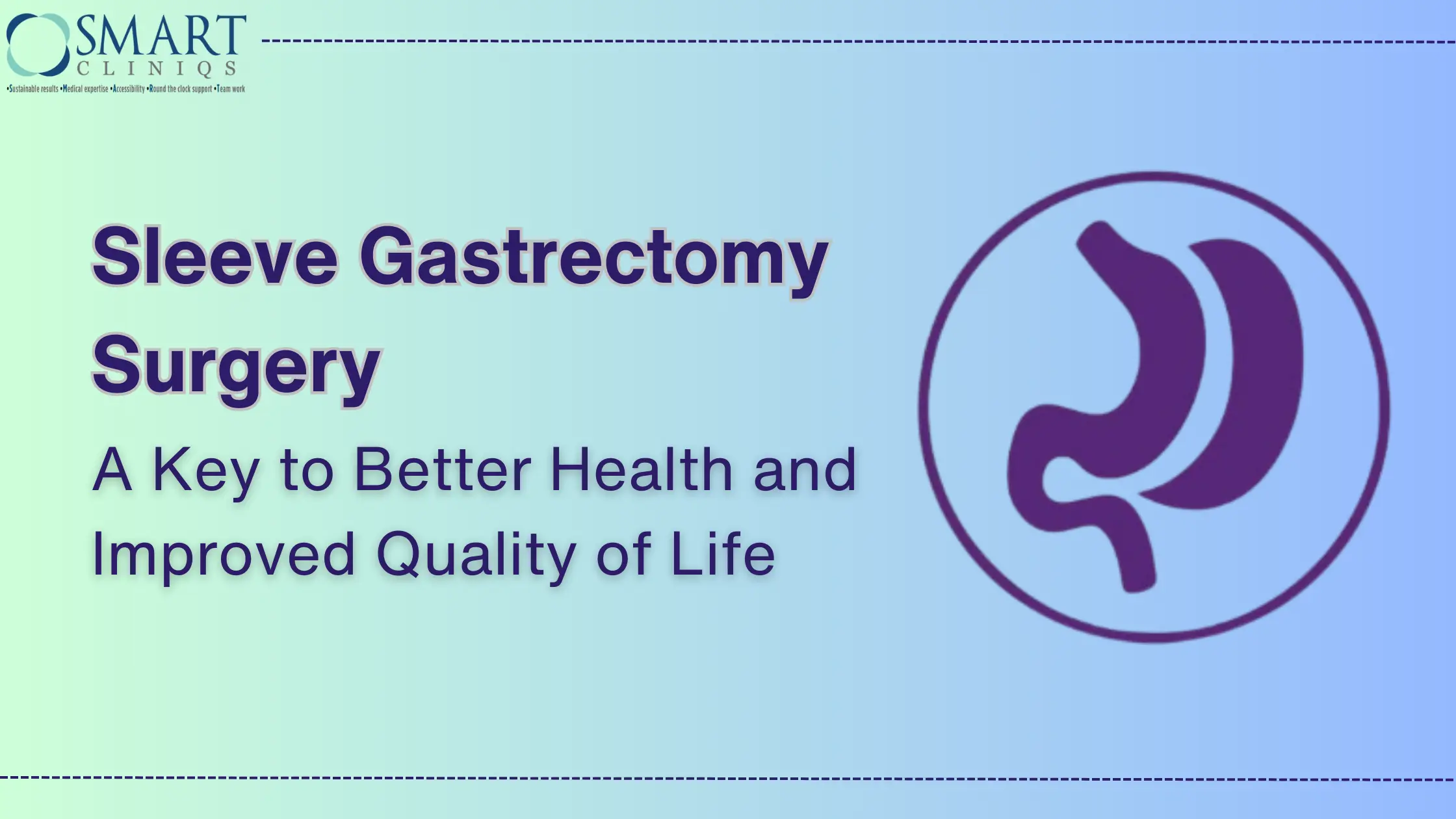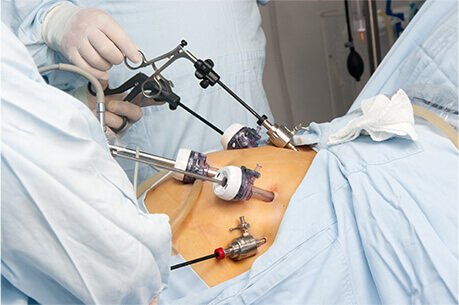
Sleeve Gastrectomy Surgery: A Comprehensive Guide to Transformative Weight Loss Surgery
Sleeve gastrectomy is a weight-loss surgery that involves reducing the size of the stomach into a tube-like shape. This is often referred to as vertical sleeve gastrectomy surgery or gastric sleeve.
This procedure helps patients eat less by limiting stomach capacity, without altering the digestive process. It’s primarily used for individuals with a BMI of 30 or higher.
Sleeve gastrectomy is considered a relatively safer surgical intervention. The procedure is typically performed using minimally invasive techniques, such as laparoscopy or robotic surgery.
Understanding Sleeve Gastrectomy Surgery
Sleeve gastrectomy involves the removal of approximately 75% of the stomach, leaving a tubular-shaped remnant. Unlike other weight-loss surgeries, it doesn’t alter the anatomy of the small intestine.
The bariatric procedure is performed under general anaesthesia. Surgeons typically employ a minimally invasive approach using laparoscopic/robotic surgery, which involves several small incisions in the abdomen. The method entails removing approximately 75-80 percent of the stomach, and reshaping the remaining portion into a narrow, banana-shaped sleeve using surgical staples. Once completed, the incisions are closed. The entire procedure usually takes between 30 to 45 minutes.
Sleeve gastrectomy significantly impacts appetite regulation by modifying gut signals associated with taste, hunger, and blood sugar control. The reduced stomach capacity limits food and liquid intake, contributing to weight loss by decreasing calorie consumption.
Moreover, by removing the portion of the stomach responsible for producing a significant amount of the “hunger hormone,” sleeve gastrectomy influences metabolism, reducing hunger, enhancing feelings of fullness, and facilitating weight management and improved blood sugar control.
Health Benefits of Sleeve Gastrectomy
People who undergo sleeve gastrectomy typically lose between 70 to 80 percent of their excess body weight. The bariatric procedure offers a transformative approach to weight management, providing a range of benefits that contribute to improved overall health and quality of life.
- Technically simple and shorter surgery time
- Can be performed on certain patients with high-risk medical conditions
- May be performed as the first step for patients with severe obesity
- May be used as a bridge to gastric bypass or SADI-S procedures
- Effective weight loss and improvement of obesity-related medical conditions
Quality of Life Improvements
A remarkable 95% of patients reported a significant enhancement in quality of life following bariatric surgery, while mortality rates decreased by a substantial 89% within five years.
- Migraines 57% resolved
- Depression 55% resolved
- Pseudotumor cerebri 96% resolved
- Obstructive sleep apnea 74% -98% resolved
- Dyslipidemia hypercholesterolemia 63% resolved
- Asthma 82% improved or resolved
- Cardiovascular disease 82% risk reduction
- Hypertension 52% -92% resolved
- Non-alcoholic fatty liver disease 90% improved steatosis; 37% resolution of inflammation; 20% resolution of fibrosis
- GERD 72% -98% resolved
- Metabolic syndrome 80% resolved
- Type II diabetes mellitus 83% resolved
- Stress urinary incontinence 44% -88% resolved
- Polycystic ovarian syndrome 79% resolution of hirsuitism; 100% resolution of menstrual dysfunction
- Degenerative joint disease 41% -76% resolved
- Venous stasis disease 95% resolved
Who Should Consider Sleeve Gastrectomy?
Bariatric surgery can be considered an appropriate alternative for:
- BMI above 32.5 kg/m2 with obesity-related co-morbidities
- BMI above 37.5 kg/m2 without co-morbidities
- BMI > 30 kg/m2 with life-threatening obesity-related disorders like uncontrolled diabetes, cardiovascular disease/cardiomyopathy and severe obstructive sleep apnea
- Patients motivated to lose weight and committed to long-term follow-up
- Patient should have attempted conservative methods of weight loss and failed in the past
- Bariatric surgery is to be considered only between the ages of 18 – 65 years
- Bariatric surgery may be considered in patients more than 65 years in the presence of severe obesity-related co-morbidities/disability
- Bariatric surgery may be considered in patients < 18 years in special situations after paediatrician/endocrinology certification, or after attainment of puberty or completion of skeletal maturity
Bariatric surgery offers potential benefits, but it’s essential to weigh these against individual risks. Your weight, age, and medical history play a crucial role in determining your suitability for surgery. To make an informed decision, careful consideration of specific guidelines and patient factors is necessary.
Choosing the Best Weight Loss Surgeon and Facility
Your choice of clinic and surgical team plays a crucial role in the success of your sleeve gastrectomy. Here’s why top bariatric surgery centres can make all the difference:
- Expertise at Every Step: A renowned bariatric surgeon runs a comprehensive bariatric program with all the infrastructure required to facilitate bariatric surgery candidates. They’ll guide you through pre-operative evaluation, ensure you have access to state-of-the-art surgical facilities, and provide extensive support post-surgery.?
- A Team You Can Trust: To run a comprehensive bariatric program, it is essential that the team comprises a Bariatric Surgeon, Bariatric Nurse, Bariatric Dietician, Program Managers and Coordinators to provide the best guidance and facility.
Before deciding, take some time to research renowned bariatric surgeons. Here are some key factors to consider:?
- Accreditation: Look out for clinics and surgeons accredited by recognized healthcare organizations, ensuring they meet the highest safety standards.?
- Surgeon’s Qualification: Research the surgeon’s experience and qualifications in performing sleeve gastrectomy. ?
- Success Rates: Inquire about the surgeon’s success rates for the procedure.?
- Patient Testimonials: Reading real patient experiences can offer valuable insights into the surgeon’s approach and patient care.?
Real-Life Success Stories
Peter Arthur, a Kenyan businessman, was struggling with severe obesity, diabetes, hypertension, high cholesterol, joint pain, and backache. His weight of 171 kilograms significantly impacted his professional and personal life.
Despite repeated attempts at diet and exercise, he was unable to achieve sustainable weight loss.
Bariatric surgery ultimately proved to be a successful intervention, leading to a weight loss of nearly 45 kilograms within a year. As a result, he has experienced significant improvements in his overall health and quality of life.
Conclusion
Sleeve gastrectomy offers a transformative path to improved health and well-being for individuals struggling with obesity. By reducing stomach capacity and regulating hunger and satiety hormones, this procedure can lead to significant weight loss and the resolution of obesity-related health conditions. However, it’s essential to remember that surgery is just the beginning. Long-term success depends on adopting healthy lifestyle changes, including balanced nutrition and regular exercise.
In cases of extreme obesity (BMI 60 or above), sleeve gastrectomy surgery can be the initial step in a two-part surgical plan. This first surgery helps patients lose significant weight, making them healthier candidates for a second weight-loss procedure, if necessary.
If you’re considering sleeve gastrectomy surgery, it’s crucial to consult with a qualified bariatric surgeon to determine if you’re a suitable candidate. By partnering with experienced professionals and committing to a holistic approach, you can embark on a journey towards a healthier, happier you.
Remember, every individual’s experience is unique. While sleeve gastrectomy has shown remarkable results for many, it’s important to manage expectations and understand the potential risks and benefits involved.





